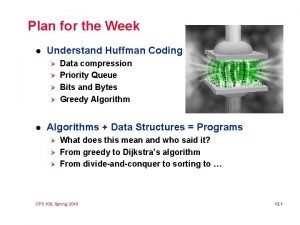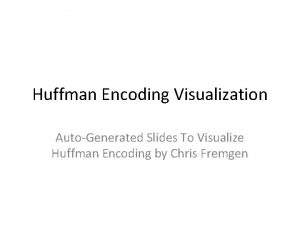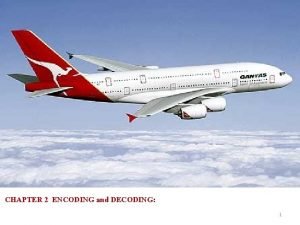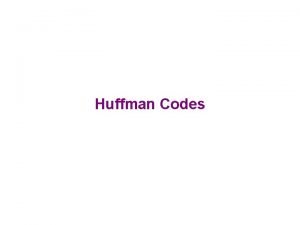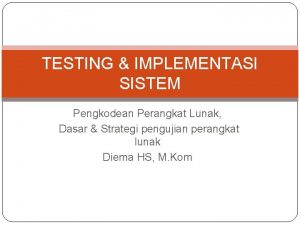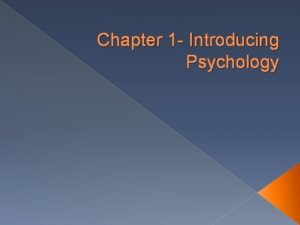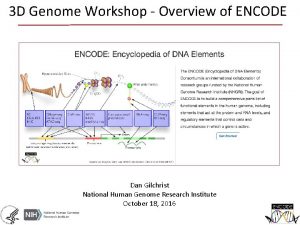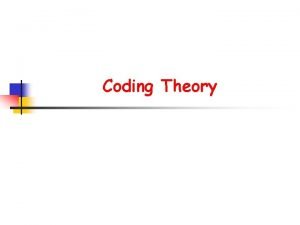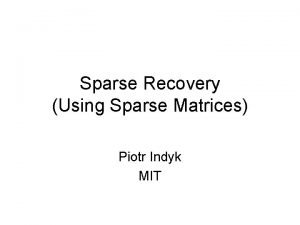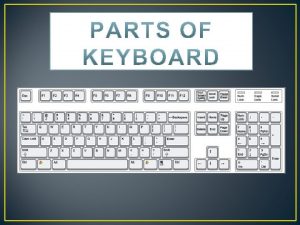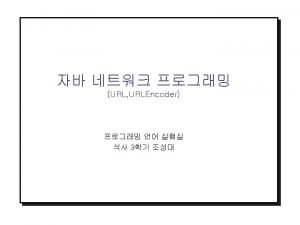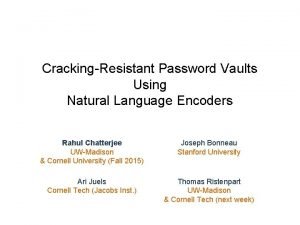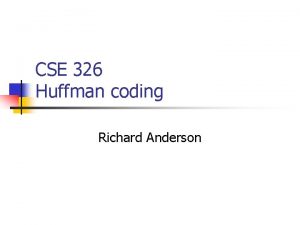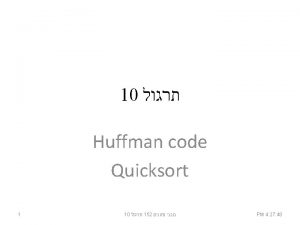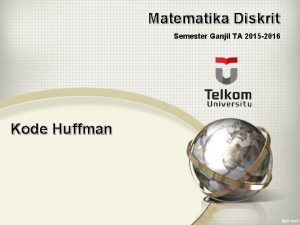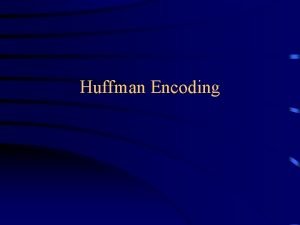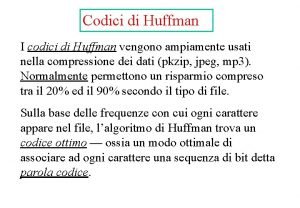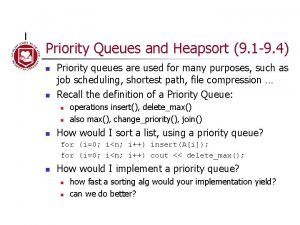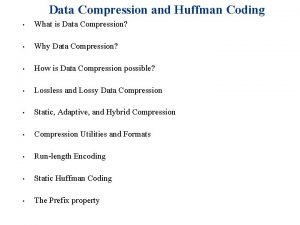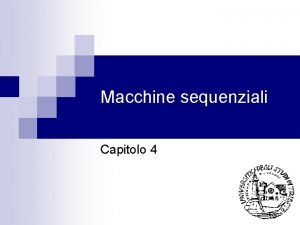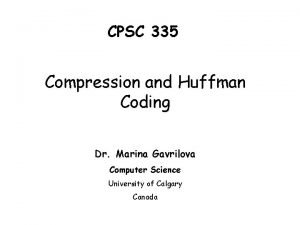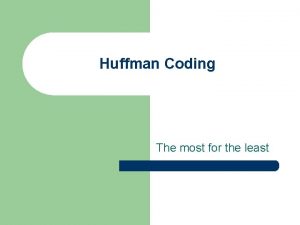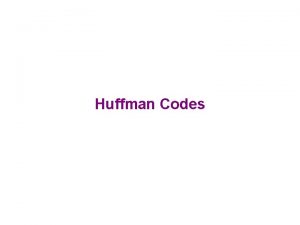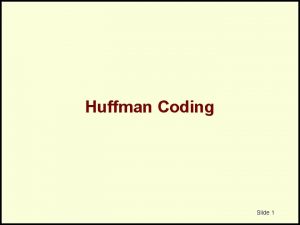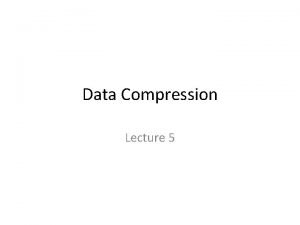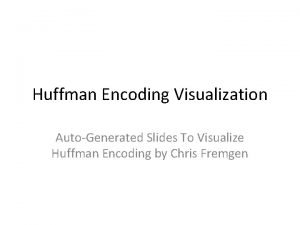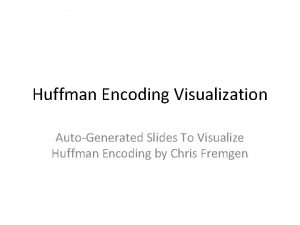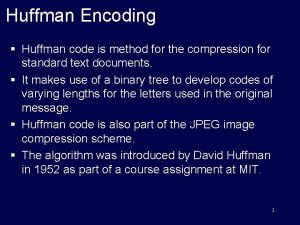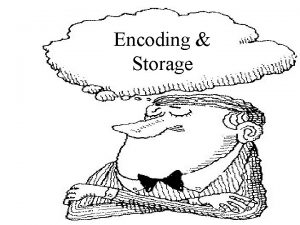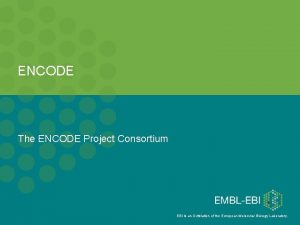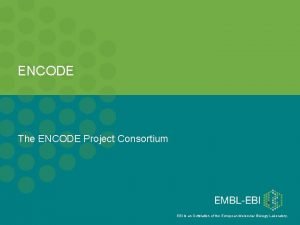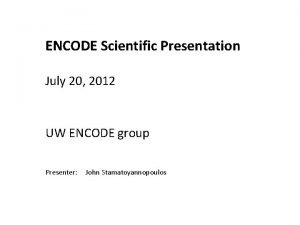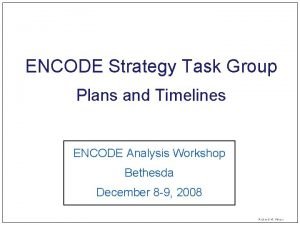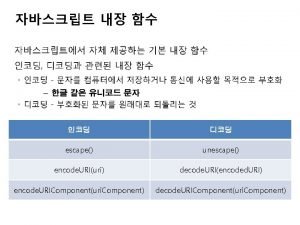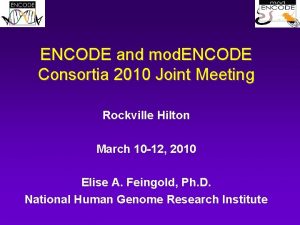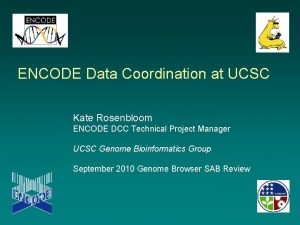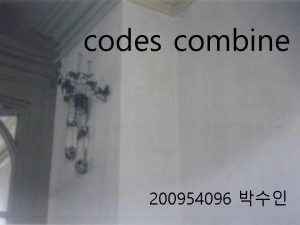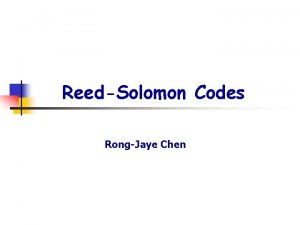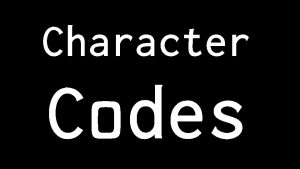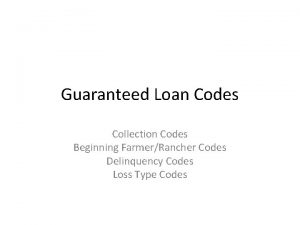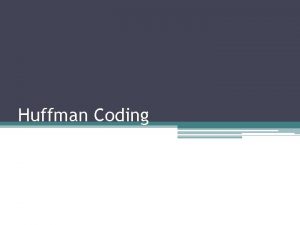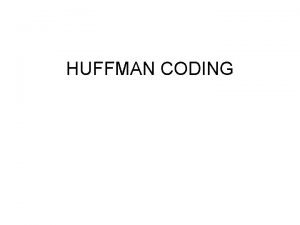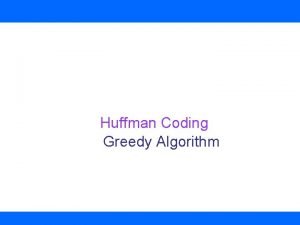Huffman Codes Encoding messages Encode a message composed

























- Slides: 25

Huffman Codes

Encoding messages Encode a message composed of a string of characters ® Codes used by computer systems § ASCII • uses 8 bits per character • can encode 256 characters § Unicode • 16 bits per character • can encode 65536 characters • includes all characters encoded by ASCII ® ASCII and Unicode are fixed-length codes § all characters represented by same number of bits ®

Problems ® Suppose that we want to encode a message constructed from the symbols A, B, C, D, and E using a fixed-length code § How many bits are required to encode each symbol? ® at least 3 bits are required ® 2 bits are not enough (can only encode four symbols) ® How many bits are required to encode the message DEAACAAAAABA? ® there are twelve symbols, each requires 3 bits ® 12*3 = 36 bits are required

Drawbacks of fixed-length codes Wasted space § Unicode uses twice as much space as ASCII • inefficient for plain-text messages containing only ASCII characters ® Same number of bits used to represent all characters § ‘a’ and ‘e’ occur more frequently than ‘q’ and ‘z’ ® ® Potential solution: use variable-length codes § variable number of bits to represent characters when frequency of occurrence is known § short codes for characters that occur frequently

Advantages of variable-length codes The advantage of variable-length codes over fixedlength is short codes can be given to characters that occur frequently § on average, the length of the encoded message is less than fixed-length encoding ® Potential problem: how do we know where one character ends and another begins? • not a problem if number of bits is fixed! ® A = 00 B = 01 C = 10 D = 11 00101101110011111 ACDBADDDDD

Prefix property A code has the prefix property if no character code is the prefix (start of the code) for another character ® Example: ® Symbol P Q R Code 000 11 01 S T 001 10 01001101100010 RSTQPT 000 is not a prefix of 11, 001, or 10 ® 11 is not a prefix of 000, 01, 001, or 10 … ®

Code without prefix property ® ® The following code does not have prefix property Symbol P Q R Code 0 1 01 S T 10 11 The pattern 1110 can be decoded as QQQP, QTP, QQS, or TS

Problem Design a variable-length prefix-free code such that the message DEAACAAAAABA can be encoded using 22 bits ® Possible solution: § A occurs eight times while B, C, D, and E each occur once § represent A with a one bit code, say 0 • remaining codes cannot start with 0 § represent B with the two bit code 10 • remaining codes cannot start with 0 or 10 § represent C with 110 § represent D with 1110 § represent E with 11110 ®

Encoded message DEAACAAAAABA Symbol A B C Code 0 10 110 D E 11101111000000100 22 bits

Another possible code DEAACAAAAABA Symbol A B C Code 0 101 D E 1101 1111 1101111100101000001000 22 bits

Better code DEAACAAAAABA Symbol A B C Code 0 101 D E 110 111 11011100101000001000 20 bits

What code to use? ® Question: Is there a variable-length code that makes the most efficient use of space? Answer: Yes!

Huffman coding tree Binary tree § each leaf contains symbol (character) § label edge from node to left child with 0 § label edge from node to right child with 1 ® Code for any symbol obtained by following path from root to the leaf containing symbol ® Code has prefix property § leaf node cannot appear on path to another leaf § note: fixed-length codes are represented by a complete Huffman tree and clearly have the prefix property ®

Building a Huffman tree Find frequencies of each symbol occurring in message ® Begin with a forest of single node trees § each contain symbol and its frequency ® Do recursively § select two trees with smallest frequency at the root § produce a new binary tree with the selected trees as children and store the sum of their frequencies in the root ® Recursion ends when there is one tree § this is the Huffman coding tree ®

Example Build the Huffman coding tree for the message This is his message ® Character frequencies ® ® A G M T E H _ I S 1 1 2 2 3 3 5 Begin with forest of single trees 1 1 2 2 3 3 5 A G M T E H _ I S

Step 1 2 1 1 2 2 3 3 5 A G M T E H _ I S

Step 2 2 2 1 1 2 2 3 3 5 A G M T E H _ I S

Step 3 2 2 4 1 1 2 2 3 3 5 A G M T E H _ I S

Step 4 4 2 2 4 1 1 2 2 3 3 5 A G M T E H _ I S

Step 5 4 2 2 4 6 1 1 2 2 3 3 5 A G M T E H _ I S

Step 6 8 4 4 2 2 E H 6 1 1 3 3 5 A G M T _ I S

Step 7 8 11 4 4 5 6 S 2 2 1 1 A G M T 2 2 3 3 E H _ I

Step 8 19 8 11 4 4 5 6 S 2 2 1 1 A G M T 2 2 3 3 E H _ I

Label edges 19 0 1 8 0 11 1 4 4 0 1 2 2 0 1 1 1 A G M T 0 1 6 5 0 1 S 2 2 3 3 E H _ I

Huffman code & encoded message This is his message S E H _ I A G M T 11 010 011 100 101 0000 0001 0010 001101111001011110001111000010010111100000001010
 Go go gophers huffman coding
Go go gophers huffman coding Huffman visualization
Huffman visualization Encode decode airport codes
Encode decode airport codes Encode a message
Encode a message Testing dikatakan baik, jika
Testing dikatakan baik, jika What is encoding in marketing communication
What is encoding in marketing communication Sender encoding message decoding receiver
Sender encoding message decoding receiver Structuralism vs functionalism
Structuralism vs functionalism National human genome research institute
National human genome research institute What are the reasons to encode the data?
What are the reasons to encode the data? Encode
Encode First ever keyboard
First ever keyboard Java
Java Encode decode
Encode decode Huffman coding
Huffman coding Huffman codin
Huffman codin Kode huffman matematika diskrit
Kode huffman matematika diskrit Huffman coding visualization
Huffman coding visualization Randy huffman west virginia
Randy huffman west virginia Codice di huffman
Codice di huffman Huffman codierung abrakadabra
Huffman codierung abrakadabra Prefix property of huffman coding
Prefix property of huffman coding Macchina di huffman
Macchina di huffman Huffman coding
Huffman coding Codifica di huffman
Codifica di huffman Huffman coding example with probabilities
Huffman coding example with probabilities
